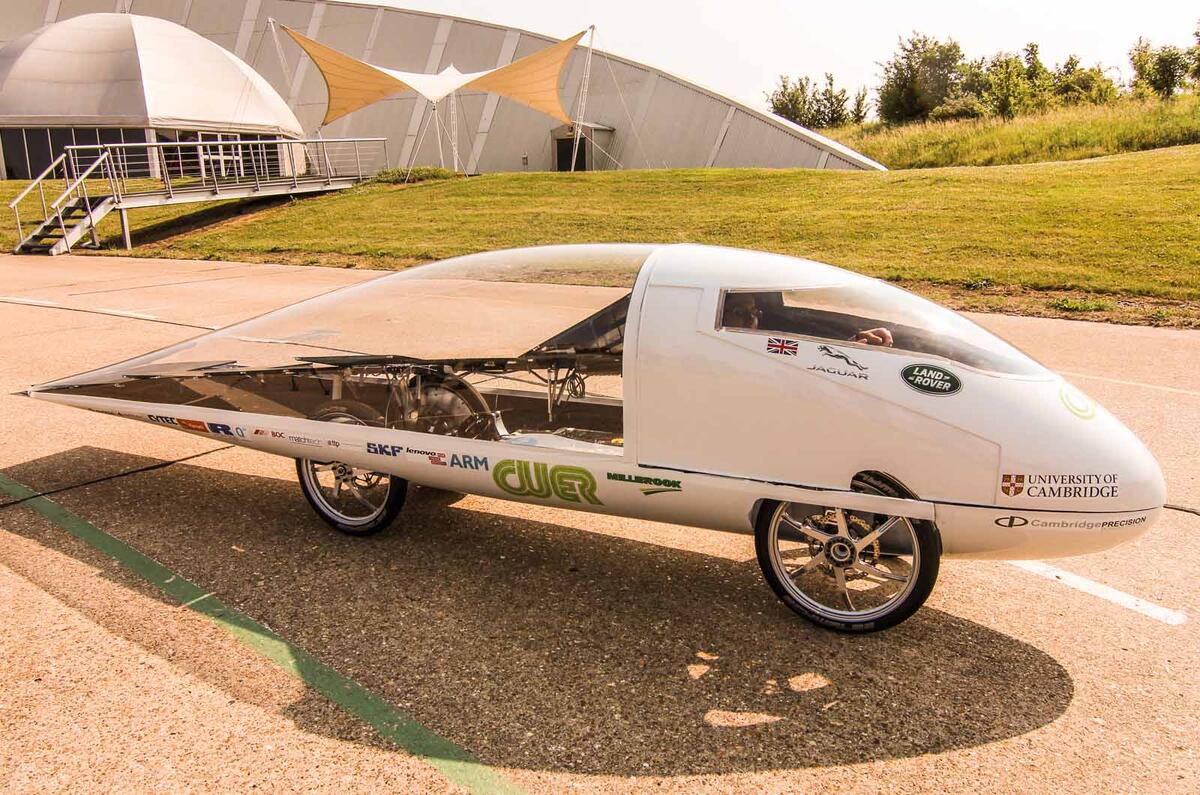Cambridge University Eco Racing, Britain's sole entrant into the World Solar Challenge, has officially unveiled its radical challenger for this year's competition.
Members of the CUER team launched the car at the Science Museum in London yesterday in preparation for October's 3000-kilometre (1860-mile) sun-fuelled race across the Australian outback from Darwin to Adelaide.
The design of the team's electric vehicle – named Resolution after the HMS Resolution, in which Captain Cook made his second voyage of exploration to the South Pacific – marks a major departure from previous WSC vehicles produced by the student team.
A rule change for this year's race stipulates that competing machines must have four wheels, whereas three-wheelers had been more popular and successful in the past. Other changes relate to driver positioning and visibility out of the vehicle.
Faced with these new challenges CUER devised the teardrop-shaped vehicle in preference to the flat, rectangular designs that have been more common in the past. Those shapes are designed to optimise the solar panels' ability to soak up the sun, but Resolution puts the emphasis on aerodynamics.
Its rear-mounted solar array, which is mounted under a clear canopy, pivots to track the movement of the sun through the sky. This means the panels remain at the optimum angle to the sun, allowing them to gather 20 per cent more power.
Resolution's tiny dimensions are also influenced by CUER's decision to use high-efficiency solar cells. The regulations place a restriction on the size of the solar array depending on the type of cells used. CUER is using spacecraft-specification gallium arsenide cells and is thus restricted to three square meters of panels. Gallium arsenide cells are both lighter and more efficient than silicon-based variants.
Propulsion comes from a rear-wheel-mounted motor. The rules permit some of the excess energy produced by the solar cells to be stored in 5kWh lithium-ion battery cells, to power the vehicle when the sun isn't out or when an incline or headwind is encountered.
The 4.5m-long car produces about 1.5kW of power – about the same as a hair dryer – but is capable of a top speed of about 85mph, although during the race it is more likely to cruise at between 50-60mph. It weighs 120kg and uses low rolling resistance tyres that are designed specifically for solar powered cars.
CUER has the support of several key automotive and engineering companies, including Jaguar Land Rover, Cambridge Precision, Lenovo and SKF. It is testing the vehicle at Millbrook proving ground and has also had access to JLR's environment testing chamber, which has enabled the team to replicate the sort of conditions that it might face in Australia.





Join the debate
Add your comment
Solar/wind conversion to CH4?
This is not essentially something new, but the students should get congratulations, nonetheless.
However, rather than try to use awkward and limited solar energy directly, it might be best to use either solar or wind* to hydrolyze sea water to form H2, which can then be converted to CH4 for easy combustion in existing ICE engines. See the Audi links below:
http://jalopnik.com/audis-carbon-neutral-e-gas-is-real-and-theyre-actuall-587518379
http://www.popularmechanics.com/cars/news/auto-blog/audis-new-e-gas-plant-will-make-carbon-neutral-fuel-15627667
http://blog.caranddriver.com/audi-opens-first-e-gas-synthetic-fuel-production-facility/
* Wind can be used next to sea areas where wind is strong (North Sea in Denmark, Holland, or Germany); Solar can be used where the sun is strong and constant (North and West Africa).
------------------------
Or a snow powered car, in
Or a snow powered car, in winter. I seem to remember a SAAB prototype which had a roof solar panel, to power a ventilation fan, when the car was parked up, on a hot day. So when you came back from your shopping, the car wasn't an oven, inside.
Roof mounted solar panels not viable
So far as I can see there are two reasons why solar panels are not used on car roofs.
1) You'd just about get enough energy from them to power say the windscreen wipers or headlights. A few watts wouldn't be enough to do anything very useful - and that's only when the sun is shining.
2) The payback time when the useful energy offsets the initial installation cost is likely to be about the same as the life as the average car, so the purchaser wouldn't gain anything.
The problem really is that energy from other sources, be they petrol, diesel or mains electricity is still very cheap.
I think for Britain what's needed is a wind, or rain powered car...
Solar panels to power HEADLIGHTS??????!!!!!!
Solar power for headlights!
Sorry, I just used the headlights as an example of something which requires around 100 - 150 watts, which is the kind of power a roof solar panel might generate.
In practice, I'm sure that the solar panel would be connected so as to provide additional battery charging, relieving the alternator of some work. In reality then, the solar panel would provide a percentage of power for everything electrical on the vehicle (including the headlights). This would fractionally improve the car's overall efficiency. But the fact that only one manufacturer is doing it suggests that the benefits are not really worthwhile.
I suspect Nissan is only doing it so as to be "seen to be green" rather than for any other reason.